| In the past, food photographers strove for images with sharp detail throughout. It is still often a desired effect, which can be achieved by using a small f-stop. Today, we also see selective focus used in food photographs to emphasize a portion of the subject or to create a mood. Let's pick apart the composition of some photos. I'll explain what makes them work and how I achieved the desired effect.  Fruit Tart This photograph and the one that follows, taken for the French Culinary Institute, are examples of how depth of field can change a mistake into a positive picture element. If you look carefully here, you can see the orange clamp holding the reflector in the background. Throwing the background out-of-focus hides the clamp, but at the same time allows its color to balance colors in the foreground. The parallel line of the clamp also reinforces the diagonal composition of the photo, a serendipitous effect. Sometimes, you just luck out! 
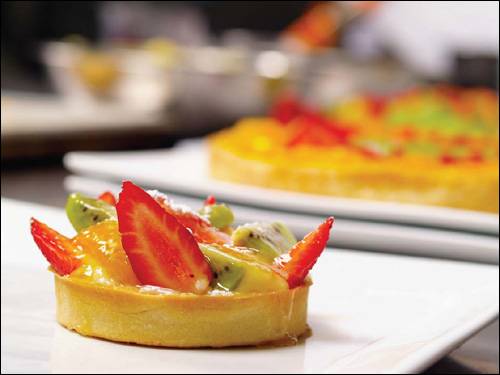  Fiddlehead Ferns When faced with photographing a variety of similar objects, you can bunch them together. In this example, I was trying to show the variations in the color and size of fiddlehead ferns. A problem in this picture is that the ferns look very small and almost entangled with one another. I rearranged the ferns to give them a tighter, more circular composition and more definition to their distinct features. I came in closer and changed the angle of the photo to give it more impact. However, I felt that the ferns didn't stand out against the muted green background. Going to a white background and brighter lighting provided more contrast, but it was too stark and clinical for these delicate greens. I continued to work with a circular composition, but because of the shape of the ferns, there were too many conflicting circles. I decided to break out of the traditional composition by focusing on one hand-held fern, putting the others in the background out of focus. I also rearranged them in a more linear fashion. The sharp focus on the fern in front makes the intricate detail stand out, while maintaining the feeling of shape, softness, and movement in the background.
  Tri-Color Peppers I started by placing a variety of peppers in rows and shooting straight down on them, because that was what the client wanted. As you can see, it doesn't look too interesting, with a stagnant composition of two vertical, parallel lines. There really isn't much movement or visual flow to the photograph. As I lowered the camera angle on the same arrangement, without moving the peppers at all, I achieved a much nicer photograph, but it was still too linear. Lowering the angle even further, while tilting the camera, makes the photo even more interesting, although it feels like the peppers are sliding off the page. Thanks to the highlights in the peppers, however, we are starting to create the shape of a lowercase "a" on its left side. This picture is much more pleasing to the eye. It has a better feeling of stability, the colors contrast well, and the composition becomes more circular with the middle pepper in the bullseye position. Lowering the camera angle, focusing on just two red peppers, and using shallow depth of field to blur out the back pepper make this photograph much more dynamic and sensual than the previous ones. The monochromatic simplicity is pretty, but it's just not interesting enough. Now we're talking. A much tighter composition, using shallow depth of field, colors, shapes, and highlights in the peppers, creates that "a" shape more clearly. This photo is much more inviting and uses the pepper stem to point your eye in the direction of composition.
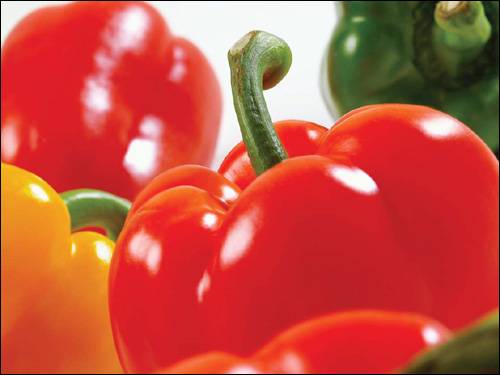  Oysters This image is similar to the peppers in that it simply represents four varieties of oysters shot from overhead. The composition is too linear, and you can almost see the parallel lines running diagonally from the top-left to the bottom-right corners of the picture. I rearranged the oysters, and used their shapes to give the picture a more circular composition. But this picture is too stark. Oyster shells on a plain white background are pretty, but have no appetite appeal. The chef added ice, seaweed, and a lemon wedge to create a more appetizing image, but the angle is too wide, and the oysters are spread out. The arrangement is much too circular. The edge of the tray also is distracting. In addition, the subtle difference in the shapes of their shells is not apparent. I moved in closer, but the oysters are still arranged in a circle, and the seaweed is center of attention. I tightened the shot even further and broke the circle. This arrangement results in a distinct lowercase "a" composition with the most interesting oyster shell the center of attention, framed by the vibrant splash of color in the cocktail sauce and lemon wedge.
  Anchovy Salad I started shooting this salad sequence at a low angle because I was amazed at how the chef was able to pile the food so high in the bowl. The picture doesn't work, though, because you can't discern the anchovies or the bread. I raised the camera angle without rotating the bowl. I was concentrating so much on achieving a circular composition, however, that I missed the hook-shaped lettuce leaf on the right until I reviewed the image on the monitor. Another plus for the immediacy of digital photography! Tip In composing your shots, concentrate on the part of the image that you feel is most important, but don't forget the small details!
I rotated the bowl clockwise and moved up to a slightly higher angle. I started get a triangular shape to the salad, and maintained the circular composition, which is defined by the shape of the bowl. That pesky lettuce leaf is still there, however. I rotated the bowl counterclockwise, because this was a better angle to see the salad and anchovies. Once again, the bowl keeps your eye moving around the photograph in a clockwise direction. Then, I tilted the camera. That was a mistake, because the angle is so steep, it looks like the anchovies are going to slide right off the top. Finally, I tilted the camera just slightly in the other direction. This photo combines the best parts of all the previous images into one. The salad looks tall, the anchovies direct your eye clockwise, and there is a very distinct triangular shape, which accentuates the elements in the salad.
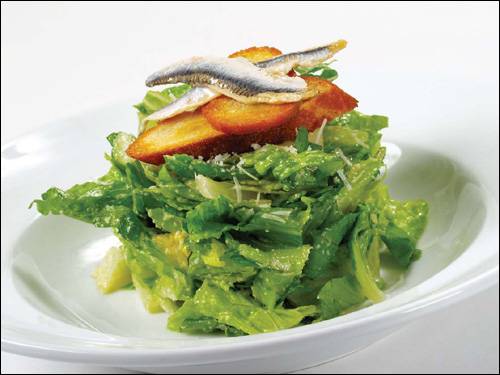  Spring Pea Risotto This was a beautiful dish because the shrimp have a spiral shape and their grilled color and texture is so appealing. They are set off beautifully by the green peas in the risotto. That said, the shot is not as compelling as it could be because the individual shrimp are not well defined and the food is too deep in the bowl. I tried a slightly higher angle and rotated the bowl counter-clockwise to get a different view of the shrimp, but the angle hid some of the shrimp. I went in very close, but that placed too much emphasis on the one large shrimp in the center. There isn't enough negative space to help the eye go into a spiral scan. This is a good shot, but very traditional, and it just feels too close. I tried a direct overhead shot. The shrimp tail on the left looks like it's not attached to anything, and it points your eye up and out of the frame. The middle shrimp is smack dab at the center of the image and it appears too flatthere is just no dimension to it. And because your eye wants to read left to right, the counter-clockwise spiral of the shrimp directs your eye out of the picture instead of into the center. Finally, repositioning the shrimp and angling the camera for a different approach gave more depth to the picture. The negative space of the bowl leads the eye from left to right into the tail, to follow the spiral shape of the shrimp into the risotto. The positive spaceoccupied by the shrimp on the lower rightplays against the negative space in the upper left.
  Oven Roasted Mussels This picture doesn't work at all. The bread dominates the dish, and you can only see the meat of one mussel. The dark shells are not appealing, and the food is too deep in the bowl. The chef added more mussels. I tried an overhead angle to show the meat inside the shells, but they were still half-closed, and the photo doesn't really show the depth of the bowl. I opened the shells further and lowered the camera angle. This gave the food much better height, shape, and visibility. The angle of the bread and the shape of the bowl now give the image a very distinct oval composition. Next, I tried a close-up since there was so much negative space in the previous photo. This didn't work because it did not give the viewer any sense of quantity, and I wanted to show that the dish was brimming with mussels. This image gives a much better sense of the amount of food in the dish and the size of each mussel in its shell. I tightened up the shot and lowered the angle slightly. Then I adjusted the position of a mussel to fill in a gap in the previous image. This is a nice, tight, circular composition, with a red and black bullseye right in the center.
  Beet Ravioli This shot was taken on location with available light to illustrate a newspaper article. I used a shallow depth of field to make the front beet ravioli stand out from the other ravioli in the background. The rim of the white plate provides a frame around it. I didn't like the shape of the front ravioli in the previous photo, so I rotated the plate to show a different ravioli framed by its out-of-focus counterparts and the white plate. I placed this ravioli at the lower left section of the "tic-tac-toe" board to add visual flow to the photo. I felt the ravioli was not standing out enough. I decided to go in another directionplacing the ravioli in the back of the photo and throwing the foreground out of focus. The rim of the plate frames the image from above, and the darker colors contrast the sauce in the background. By rotating the dish once again, I was able to achieve a much prettier shape, design, and reflection of light. Now the ravioli really stands outframed perfectly by the white plate on top (where your eye starts reading the photograph), the prominent yellow sauce, and the out-of-focus ravioli in the foreground. You really want to reach into the picture and grab it!
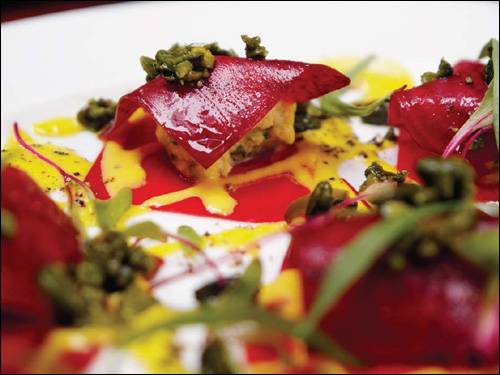  Blueberry Crème Brûlée I started with a standard composition showing the entire dish at a level angle. There is no movement in the imagethe blueberries look like they are just sitting on top of a flat surface. I tried a close-up on the blueberries, but they overpower the image and become the focus of attention because of their placement in the center of the image, their triangular arrangement, and the sweep of the dish's rim. I rotated the dish, which moved the blueberries off to the side, and I pulled back to show more of the crème brûlée. The edge of the dish gives the image an oval composition. I still wanted to do something with those blueberries. I rotated the dish, tilted the camera, and raised the angle a bit to open up the oval composition. However, the steep angle makes it look like the blueberries will roll off to the right. I kept the same camera angle but rotated the dish back. Now, the blueberries balance the composition and are anchored at the bottom of the picture. They help create a frame in the foreground to keep your eye in the middle of the soft-focused crème brûlée.
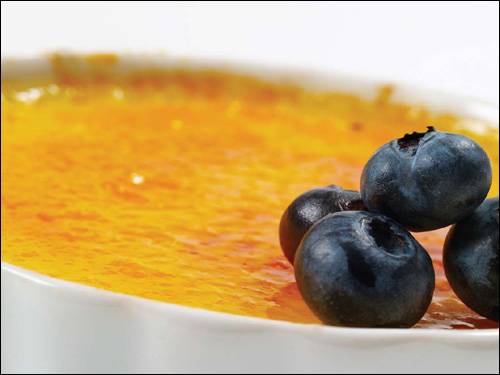  Phyllo Purse I took this photo with a wide-angle lens. The scoops of ice cream appear as large as the phyllo purse in the background, and there is too much distance between the objects because the wide angle lens exaggerates perspective. I reversed the angle of the dish to emphasize the phyllo, but now it appears disproportionate to the scoops of ice cream, which look too far away. I changed to a telephoto lens. This compressed the distance between the phyllo and ice cream, and made them appear in better proportion and closer together.
Note Wide-angle lenses make elements in the foreground appear larger than those in the background, and exaggerate distance and perspective. Telephoto lenses, on the other hand, have an opposite effect. They compress distance and make objects in the background appear similar in size to objects in the foreground. Remember that depth of field is shallower with telephoto lenses.
 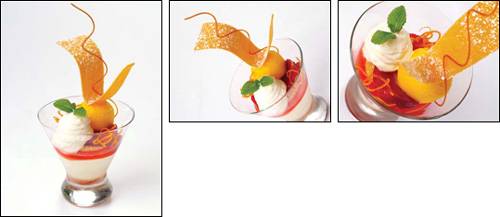 Passion Fruit Sorbet I began with a plain, vertical composition because of the height of the dish and the interesting shapes of the sorbet and garnishes. However, this straight-on traditional angle lacks anything dynamic. A simple tilt of the camera allowed me to get closer, from a slightly higher angle. This angle works with the caramel swirl to point your eye into the sorbet. It helps the composition, but it feels like the glass is going to fall over. Tilting the camera in the other direction and looking down into the glass provides the perspective needed to spiral your eye into the picture and get closer to the sorbet. The problem is that the curl of the wafer blocks the sorbet at this angle. Lowering the angle exposes more of the sorbet. The white negative space gets your eye to start on the left and track clockwise through the upper part of the photograph, while the caramel swirl and wafer direct it back into the sorbet in the center. The overall feeling is much more fun, festive, and exciting.
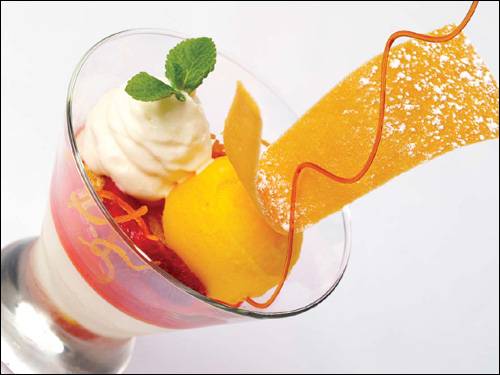 |






















